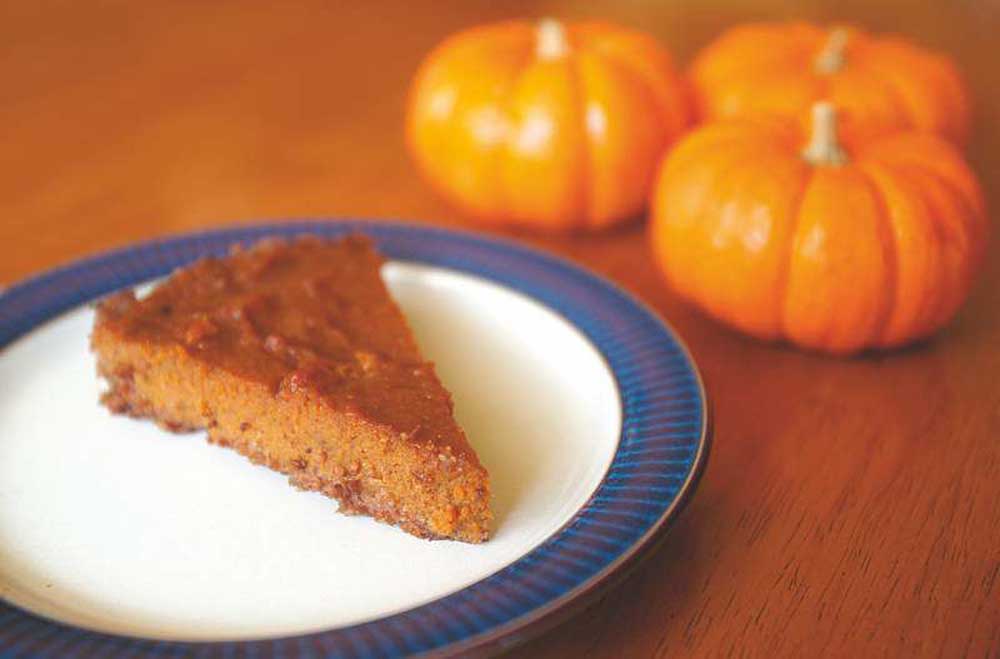Recipes: Thanksgiving inclusion
Published 4:00 am Tuesday, November 12, 2013

- Paleo Pumpkin Pie works as a dessert for any guests sticking to a Paleo, or “caveman,” diet.
Not so long ago, the only questions home cooks had to ask their guests at Thanksgiving dinner were, “white or dark meat?” and “want whipped cream or ice cream on your pie?”
Nowadays, dietary restrictions, food allergies and special diets can complicate holiday meals.
Vegans don’t eat meat, dairy and other animal products.
Gluten-free and Paleo diet folks don’t eat grains, so traditional bread stuffing is out.
Heart-healthy eaters avoid fats and salt, so there go the buttery mashed potatoes and gravy — or maybe not.
To help us come up with Thanksgiving menu options that will please a variety of people with special diets, we talked to Garrett Berdan, a registered dietician, nutrition and culinary educator, chef and food consultant who lives in Bend.
A few easy substitutions and ingredient changes can result in holiday foods that everyone will enjoy.
And a new side dish just might become a new tradition.
Vegan
Vegans are like super vegetarians. Their diet is plant-based, and they do not eat any products from animals. That means no meat, fish, dairy (milk, cheese or yogurt), eggs or honey.
“That takes away the traditional entree, so you’re looking for another entree your vegan guest can enjoy and one the others can try and enjoy too.
“What you end up losing is that savory or umami flavor that meat has, so look for other ingredients that aren’t animal products that have that taste, like miso paste, soy sauce, tomatoes — fresh, canned, sundried, ketchup — caramelized mushrooms, olives and sauerkraut. These are some of the foods with that savory note. Look for recipes that include one or some of these ingredients,” Berdan said.
A vegan recipe for Portobellos Stuffed with Chickpeas and Chard and a recipe for Braised Winter Squash, made with olive oil, not butter, are likely to please a lot of palates (see recipes), especially the vegans at the table.
You can cook these recipes a day before and reheat them in the microwave if oven space is at a premium on Thanksgiving.
Be sure to steer clear of using meat broth in recipes if you have vegan guests.
“Use vegetable broth. A lot of omnivores forget that chicken and beef broth are made with chicken and beef. It’s easy to forget,” Berdan said.
Gluten-free
The gluten-free diet avoids gluten, a protein found in wheat, barley, rye and triticale (a cross between wheat and rye), so baked goods, desserts, stuffing and sauces thickened with flour are a problem.
“The meat entree is not an issue with gluten-free, but the gravy is. To make gluten-free gravy, thicken it with a slurry made with arrowroot flour or corn starch mixed with water or broth, instead of all-purpose flour, and you’re good to go. It will not taste different at all,” Berdan said. (See the recipe for gluten-free gravy.)
Use gluten-free bread for stuffing, and try a savory gluten-free grains medley side dish.
Berdan, who trained as a chef, suggests making a rice or quinoa side dish, with some flavor and texture elements added.
“With grain side dishes, crunchy toasted pecans, dried cranberries or cherries are good, plus roasted diced squash to add a vegetable and something soft,” Berdan said.
Desserts can be an issue for gluten-free people.
“We’re so used to eating pie at Thanksgiving, and if you must have pie — and I must have pie — purchase a store-bought gluten-free pie crust. Or try something new, like a pumpkin custard or panna cotta with Christmasy spices in it, or poached pears with star anise,” Berdan said.
Paleo
The Paleo diet, also known as the “caveman diet,” is based on the idea that the healthiest food for us is the same that our hunter-gatherer ancestors ate: mainly meat, fish, eggs, vegetables, fruits, nuts and seeds. No grains, dairy, processed foods or refined sugars.
“The Paleo person would not partake in the stuffing or dessert. Your traditional entree will work and vegetable side dishes are great — even the green bean casserole, unless it has dairy in it. You could do a roasted squash side dish with toasted sliced almonds or pumpkin seeds and no one else would know the difference or miss anything,” Berdan said.
For dessert, we found a Paleo Pumpkin Pie with a ground pecan crust and Paleo Truffle candy (see recipes) made with cacao, coconut oil, almond butter, honey and cinnamon that will satisfy most guests who saved room for a sweet treat at the end of the feast.
Heart healthy
Eating “heart healthy” means a diet low in fat and sodium.
“It doesn’t mean you can’t have animal protein as an entree, but I’d suggest a turkey breast (see recipe), or a beef tenderloin or filet because those aren’t highly marbleized cuts. Best of all, you can please the whole family with salmon. It’s heart healthy as long as it’s not basted with butter,” Berdan said.
For heart healthy mashed potatoes, Ellie Krieger’s Garlic Mashed Potatoes (see recipe) does not have any butter, milk or cream, but she promises that by using Yukon gold potatoes, garlic and a touch of olive oil, you’ll get creamy, delicious results.
“Mashed potatoes are truly the best when they have almost equal parts butter to potatoes, but that’s not a great option for anyone! Instead of butter, infuse reduced fat 2 percent milk with a garlic clove or roasted garlic, add thyme sprigs, some parsley stems, a bay leaf and some peppercorns. Warm the milk, then strain it, and incorporate some of that flavorful milk with the mashed potatoes. You’ll get flavor instead of a lot of butter or fat,” Berdan said.
When cooking low sodium, think about adding more flavors instead of salt.
“Bump up all the flavors by using fresh herbs and other spices. Ingredients that are a little acidic, like vinegar and lemon juice, can add an element of taste so that you won’t miss the salt as much,” Berdan said.
Thanksgiving dinner is all about tradition and nostalgia, but the guests around the table make the day special. Have fun trying some new recipes to cater to the special food needs of your special friends and relatives.
.articleImage {display: none;}






